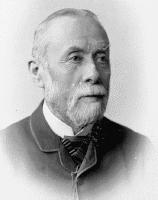Alexander Hislop

Alexander Hislop (1807 – 13 March 1865) was a
Alexander was born and raised in
He wrote several books, his most famous being The Two Babylons: Papal Worship Proved to be the Worship of Nimrod and His Wife, which is discredited by many historians.
The Two Babylons
This book, initially published in 1853 as a pamphlet, was greatly revised [citation needed] and expanded and released as a book in 1858.
In the book, Hislop argued that the Catholic Church was a Babylonian
Hislop believed that the goddess, in Rome called
According to Hislop, Semiramis was an exceedingly beautiful woman, who gave birth to a son named
Hislop attempted to show that the cult and worship of Semiramis spread globally, her name changing with the culture. In Egypt she was
Constantine's endorsement of the tradition was a turning point for
Books by Alexander Hislop
(Sources of information include [http://copac.ac.uk COPAC)
- Christ's Crown and Covenant: or national covenanting essentially connected with national revival (Arbroath and Edinburgh, 1860)
- Infant Baptism, according to the Word of God and confession of faith. Being a review, in five letters, of the new theory of Professor Lumsden, as advocated in his treatise entitled, "Infant baptism: its nature and objects." (Edinburgh, 1856)
- The Light of Prophecy let in on the dark places of the Papacy (exposition of 2 Thess 2: 3–12) (Edinburgh, 1846)
- The Moral Identity of Babylon and Rome (London, 1855)
- The Red Republic; or Scarlet Coloured Beast of the Apocalypse (Edinburgh, 1849)
- The Rev. E.B. Elliott and the "Red Republic" (Arbroath, circa 1850)#
- The Scriptural Principles of the Solemn League and Covenant: in their bearing on the present state of the Episcopal churches (Glasgow, 1858)
- The Trial of Bishop Forbes (A lecture delivered in East Free Church, Arbroath) (Edinburgh, 1860)
- Truth and Peace (in reply to a pamphlet, entitled "Charity and mutual forbearance" by "Irenicus") (Arbroath, 1858)
- The Two Babylons; or, the Papal Worship proved to be the worship of Nimrod and his wife (Edinburgh, 1853 & 1858)
- Unto the Venerable the General Assembly of the Free Church of Scotland: the petition of the undersigned (relates to James Lumsden on "Infant Baptism": Hislop was head signatory of this petition) (Edinburgh, 1860)
Bibliography
- Ewing, William: Annals of the Free Church of Scotland 1843–1900 (Edinburgh, 1914)
References
External links
- Works by Alexander Hislop at Project Gutenberg
- Works by or about Alexander Hislop at Internet Archive
- The Two Babylons by Alexander Hislop (online)
- ISBN 0-916938-17-4(critique from former advocate).
- Genealogical page on Jamie Hayter's family history site Note: shows different date of birth for Alexander Hislop - clarification being sought
